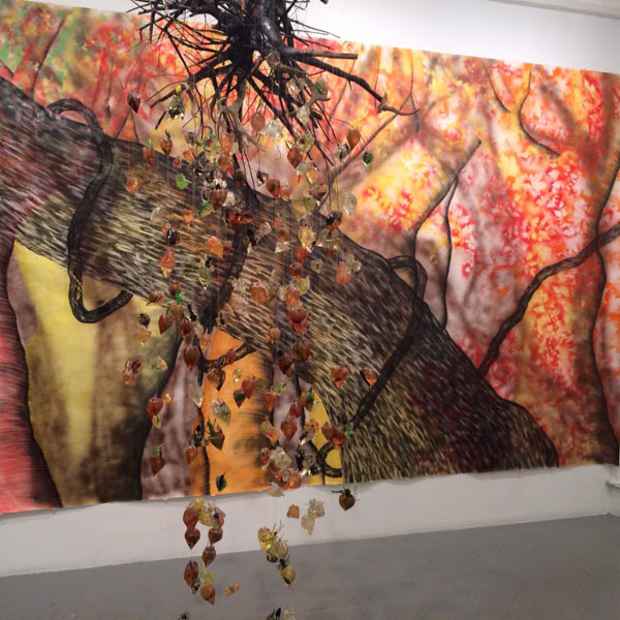Seung Lee “An Ardent Nature”
Kips Gallery

This event has ended.
Seung Lee is a hybrid of two cultures; born and raised in Korea, he also has lived for many years in the United States, particularly in the New York City area, where he maintains a studio and teaches art at Long Island University. It can also be said that Lee is a hybrid artist, melding the double environments he has had experience with, in ways that enhance and complicate (in a good way) his esthetic. Certainly, his art is given to the portrayal of nature; his complex, beautiful compositions include fantasy trees, falling stars, yellow jacket bees, and dragonflies. Often incorporated into an abstract environment, Lee’s imagery is strikingly accurate from a scientific point of view. Such attention to detail enables the artist to work out, ironically enough, a fantasy of nature that includes a view of the creatures as predators, as well as abstract backgrounds that push the work toward subtle and brilliant studies of patterning. As a result, we cannot say that Lee is a figurative artist only; rather, he is a technically gifted artist who embraces nonobjective and figurative art in the pursuit of a new vision of natural life. A sense of struggle obtains in Lee’s art; the meeting of styles also can signify confrontation or fighting, perhaps with the goal of conflict resolution and ultimately balance.
We can develop the evidence for our thesis from the pictures themselves. In Fantasy Tree (2012), we see a twisted, arcing trunk with branches outlined in white; leaf forms and what look like magnified cells add visual interest to the central image of a tree turning this way and that. The trunk and branches themselves are transparent, revealing an abstract layer underneath. Although the treatment of the tree is quite beautiful, it is also part of a gestalt that communicates threat—the environment serves as a field in which cultural as well as natural dichotomies are worked out. The same sense of darkness is seen in Dragonfly (2013), a nearly hyperrealistic study of the insect with a black body and transparent, silver wings. The background of the image consists of a transparent, silver circle with white scratch marks, around which is a brown frame showing off black splotches. The dragonfly is depicted as a formidable creature. Larger than life, the artist’s rendition demonstrates an impressive body and wings, which look generally ominous to his audience.
These works are anchored by Lee’s strong sense of line, which in turn emphasizes detail of some untoward aura. In this sense, his paintings can be impressively aggressive, with uncontained threat. Yet the menace can be read as part of an innate dichotomy between cultural difference and even difference in the artist’s materials; in other words, aggression and vulnerability, death and rebirth, common to us all, are reborn in Lee’s work. But we should remember that Lee does not only offer a realistic interpretation of nature; he also includes abstraction of a fanciful kind. Lovefight (2013) includes two bees, one in black and yellow stripes and the other in black and green stripes, closely circling each other in a dance suggesting eroticism and death at the same time. The ground is gray with broken lines encircling the two insects; a light-gray background with splotches of darker gray demonstrate how Lee can render abstraction as a support of the bees, which are painted so that they are nearly abstract themselves. Again, we come across dualities, which the artist has commented as proceeding from a bi-cultural fabric of experience. Falling Stars (2013) show Lee’s audience nature as a category of lyric beauty. At the top of the painting, we see stars of several colors—red, purple, and blue among them—drip color from their points down the thick trunk of a tree detailed in white. The drips almost reach the bottom of the canvas, bringing interest to the lower spaces, which are complicated by imagery that looks like foliage or underbrush. It is a very beautiful painting, made more so by the presence of the imagery imagined rather than drawn from life.
Lee will eventually be seen as a painter of acute imagination—someone willing to experiment with and elaborate his sinuous, exacting art. It is important to remember at the same time that his dualisms are not imaginary but real, in the sense that they carry forward a view of very different influences resulting from the two countries where he has lived. The dualities cannot be reconciled, although they can be juxtaposed in the imagination—the conflict is actual, accounting for the works’ implicit aggression, and will not go away.
Media
Schedule
from December 12, 2013 to December 30, 2013
Opening Reception on 2013-12-12 from 18:00 to 20:00